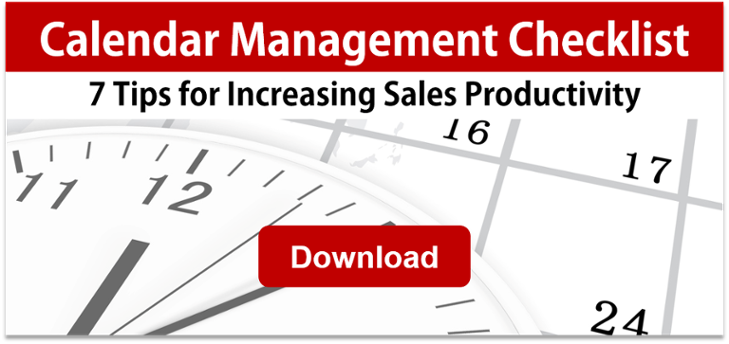How to Improve Your Sales Presentations
Before you can improve your sales presentations, it’s important to have a strong understanding of the difference between demonstrating and presenting.
We’ve seen it time and time again that sales people (and sometimes even managers!) have been using these terms interchangeably but these two things are very different. And knowing the distinction will make all of the difference when improving your sales presentations.
Let me explain…
Want to learn how to keep better track of your appointments and day=to-day schedule? Download our calendar management checklist:
Demonstrating vs. Presenting
When you demonstrate, you’re still in the process of gathering information. However, when you present, you are confirming that what you are saying is correct and defending the ROI of the offer.
Standing up in front of a customer or prospect to show him how the product works is not necessarily the same as presenting. When you’re demonstrating, you should try to speak and listen simultaneously. While presenting, you’re listening for a reaction and only looking for the affirmative nodding of the head from the audience, which signals agreement with everything that you’re saying.
When you present, you’re looking for a positive reaction but when you demonstrate, you’re anticipating a negative one.
Here is the reality that many of us are all too familiar with:
When somebody is not seriously considering adding something new to their life, you say to them, “You know I’d like you to start doing this thing,” or “Let me suggest this for you to do.”
If the person you were telling this to wasn’t seriously considering implementing your suggestions, they may give you a very “service” answer – something along the lines of “Yeah, yeah, that’s good. Yeah, that sounds interesting. Mm-hm.”
However, once people begin to seriously consider pursuing something new (after all, that’s what we’re doing when we sell somebody something), you will be the one helping them with a new or slightly new endeavor. Why? Because they’re going to take on that challenge with you side-by-side from here on out. They are going to do something with you that they’ve never done before. And when they really start to think about changing, some of the challenges and reasons that they’ve been doing it the way that they have will naturally rise to the surface. They begin to focus on all the possibilities that could take them in the wrong direction. That’s actually a good sign because it implies that the person is truly considering the implementation.
Now that you understand demonstrating and presenting, let’s dive into our top 5 tips that apply to both. These top tips will help you improve your sales presentations and land your next deal.
Our Top 5 Tips to Help You Improve Your Sales
Since the dawn of PowerPoint’s existence, salespeople have been using it to make presentations and pitch their services. They were used as support for presenting an offering. Now over 25 years later, salespeople in general still approach PowerPoints the same exact way. So much has changed in how sales is done that we need to take a step back to reevaluate.
Chances are that you, as a B2B salesperson, are responsible for having some kind of sales deck in your arsenal. Some companies may have their marketing teams prepare these, while for most others - you’re on your own. Perhaps dependent on the products or services you’re selling, you may have a few presentations at the ready. It’s time to rethink and revamp the materials you have to help guarantee it’s going to have an impact and actually aid your sales process.
Present Versus Send
First things first: How many of your decks do you actually present - either in person or via screenshare - and how many are just being sent as an email attachment for your contact to look over? What you’re using when you’re making a live presentation should be entirely different than what you’d send to someone.
An actual deck you present would essentially contain only talking points and items that would require you to elaborate on and explain. If you attached that deck to an email, whoever would be on the receiving end would completely miss out on any necessary commentary. Can you imagine their confusion? Now maybe you’ve spoken with that contact previously so perhaps they do have some necessary background, but how about anyone they forward that particular email to? You get the picture. That’s why all decks should be differentiated into those you would speak to and those meant for being distributed without additional narration. Making this distinction when using a sales deck is crucial and will impact your success.
Clear and to the Point
Your B2B buyer is busy. You’ve probably had trouble getting in touch with them and even had meetings fall through due to constant conflicts. So why would you ever burden them with an overstuffed, dense deck? Whether you’re actually presenting it to them live or sending it, make sure the presentation has clearly stated objectives and gets to the point. Placing one idea per slide will help streamline and focus the flow of the deck. Including too much unnecessary material will only help you lose a prospect’s attention and potentially the sale.
Keep it Interesting
If your sales deck has slide upon slide of company background, etc., you can bet many people won’t want to continue. Making the deck about them and how you intend to help, serve, or ease specific pain-points is how you’ll keep them engaged in your offering. It’s great to include some background, especially some relevant client testimonials for example, but overall you should limit how much you talk about you and keep the focus on them. Stop trying to sell yourself and get them sold on your idea.
What’s the Point?
Having a next step in mind when using a sales deck is key. If you’re presenting it live you should have an idea of what you’d like to do next. A follow-up discussion? A proposal? When sending a presentation via email maybe you can include some kind of CTA (call to action) so that they can easily access relevant additional information and you can gauge their interest level in a secondary way. Knowing exactly what the point and ultimate goal of showing a prospect your sales deck is helps everyone stay on the same page and moves the process along.
It’s All in the Details
If you’re sending someone an email with your sales presentation attached, they really don’t want to see “SalesDeck.pptx” in their downloads folder when they’re trying to open it. Renaming the file while keeping in mind what the deck is to them is an additional thoughtful step they’ll be grateful for. So instead of “SalesDeck.pptx”, try naming it something like “XYZ company Presentation for ABC company.pdf”.
Notice that .pdf? Sending a PowerPoint (or the equivalent) file is cumbersome. The file is large and do you really want them editing your presentation anyway? Taking a moment to make the file a PDF will ensure the file will fit as an attachment and your prospect won’t be able to make any edits. It also looks much sleeker, is more secure and easier to open.
Speaking of easier to open… Attachments are generally really annoying. If you and your company has the ability to avoid the seemingly necessary evil, then why don’t you? Uploading the file and simply sending the prospect a link is quite easy and can even give you a way to track whether they’ve viewed it.
Sales presentations should improve and evolve. Taking time to get your decks in order should be a priority that needs to be revisited regularly to ensure they are effectively providing value to your prospect and helping you make the sale.
But preparing for your next presentation isn’t the only thing you need to do to make sure you’re on track to close your next deal. Take it a step further and download our Calendar Management Checklist to help you structure your day more wisely:
About Molly D Protosow
Molly Protosow is the COO and Training Strategist for DMTraining. She manages the day-to-day business and training operations while helping research and develop new training programs as well as refreshing signature programs to reflect the newest sales trends, technology, and best practices. Molly utilizes her wide-range of skills to create sales and marketing assets focused on delivering value to DMT’s clients. Molly has a passion for learning and leveraging new knowledge and experiences. Outside of DMTraining, Molly is a hard core Pittsburgh sports fan, enjoys staying active by running and golfing, and unwinds by reading and playing the piano.






